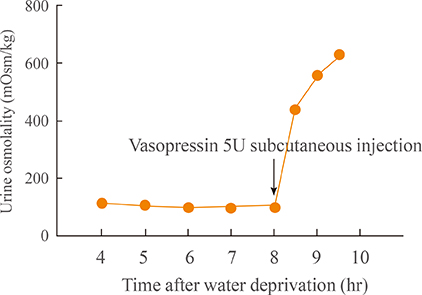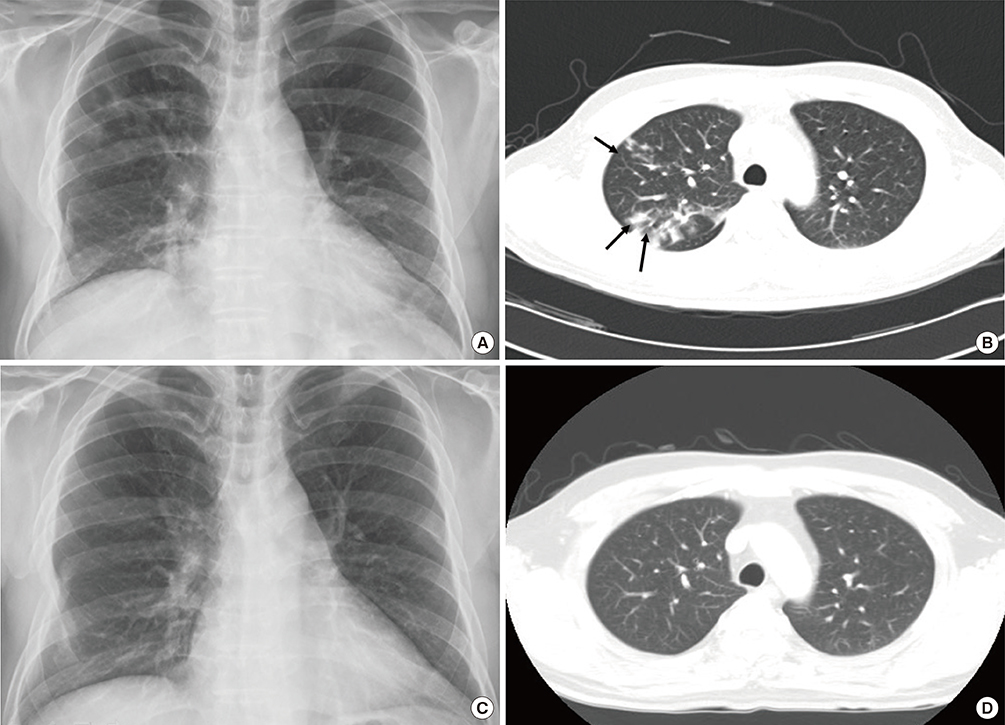Endocrinol Metab.
2014 Sep;29(3):394-399. 10.3803/EnM.2014.29.3.394.
Adult Multisystem Langerhans Cell Histiocytosis Presenting with Central Diabetes Insipidus Successfully Treated with Chemotherapy
- Affiliations
-
- 1Division of Endocrinology and Metabolism, Department of Internal Medicine, Hallym University College of Medicine, Chuncheon, Korea. hegletter@hallym.or.kr
- 2Division of Endocrinology and Metabolism, Department of Internal Medicine, Hallym University Dongtan Sacred Heart Hospital, Hwaseong, Korea.
- 3Division of Endocrinology and Metabolism, Department of Internal Medicine, Seoul National University College of Medicine, Seoul, Korea.
- 4Division of Hematology, Department of Internal Medicine, Hallym University College of Medicine, Chuncheon, Korea.
- KMID: 2169478
- DOI: http://doi.org/10.3803/EnM.2014.29.3.394
Abstract
- We report the rare case of an adult who was diagnosed with recurrent multisystem Langerhans cell histiocytosis (LCH) involving the pituitary stalk and lung who present with central diabetes insipidus and was successfully treated with systemic steroids and chemotherapy. A 49-year-old man visited our hospital due to symptoms of polydipsia and polyuria that started 1 month prior. Two years prior to presentation, he underwent excision of right 6th and 7th rib lesions for the osteolytic lesion and chest pain, which were later confirmed to be LCH on pathology. After admission, the water deprivation test was done and the result indicated that he had central diabetes insipidus. Sella magnetic resonance imaging showed a mass on the pituitary stalk with loss of normal bright spot at the posterior lobe of the pituitary. Multiple patchy infiltrations were detected in both lung fields by computed tomography (CT). He was diagnosed with recurrent LCH and was subsequently treated with inhaled desmopressin, systemic steroids, vinblastine, and mercaptopurine. The pituitary mass disappeared after two months and both lungs were clear on chest CT after 11 months. Although clinical remission in multisystem LCH in adults is reportedly rare, our case of adult-onset multisystem LCH was treated successfully with systemic chemotherapy using prednisolone, vinblastine, and 6-mercaptopurine, which was well tolerated.
MeSH Terms
-
6-Mercaptopurine
Adult*
Chest Pain
Deamino Arginine Vasopressin
Diabetes Insipidus
Diabetes Insipidus, Neurogenic*
Drug Therapy*
Histiocytosis, Langerhans-Cell*
Humans
Lung
Magnetic Resonance Imaging
Middle Aged
Pathology
Pituitary Gland
Polydipsia
Polyuria
Prednisolone
Ribs
Steroids
Tomography, X-Ray Computed
Vinblastine
Water Deprivation
6-Mercaptopurine
Deamino Arginine Vasopressin
Prednisolone
Steroids
Vinblastine
Figure
Reference
-
1. Writing Group of the Histiocyte Society. Histiocytosis syndromes in children. Lancet. 1987; 1:208–209.2. Broadbent V, Egeler RM, Nesbit ME Jr. Langerhans cell histiocytosis: clinical and epidemiological aspects. Br J Cancer Suppl. 1994; 23:S11–S16.3. Baumgartner I, von Hochstetter A, Baumert B, Luetolf U, Follath F. Langerhans'-cell histiocytosis in adults. Med Pediatr Oncol. 1997; 28:9–14.4. Stockschlaeder M, Sucker C. Adult Langerhans cell histiocytosis. Eur J Haematol. 2006; 76:363–368.5. Arico M, Girschikofsky M, Genereau T, Klersy C, McClain K, Grois N, Emile JF, Lukina E, De Juli E, Danesino C. Langerhans cell histiocytosis in adults. Report from the International Registry of the Histiocyte Society. Eur J Cancer. 2003; 39:2341–2348.6. Ladisch S, Gadner H. Treatment of Langerhans cell histiocytosis: evolution and current approaches. Br J Cancer Suppl. 1994; 23:S41–S46.7. Arico M. Langerhans cell histiocytosis in adults: more questions than answers? Eur J Cancer. 2004; 40:1467–1473.8. Makras P, Alexandraki KI, Chrousos GP, Grossman AB, Kaltsas GA. Endocrine manifestations in Langerhans cell histiocytosis. Trends Endocrinol Metab. 2007; 18:252–257.9. Grois N, Flucher-Wolfram B, Heitger A, Mostbeck GH, Hofmann J, Gadner H. Diabetes insipidus in Langerhans cell histiocytosis: results from the DAL-HX 83 study. Med Pediatr Oncol. 1995; 24:248–256.10. Shioda Y, Adachi S, Imashuku S, Kudo K, Imamura T, Morimoto A. Analysis of 43 cases of Langerhans cell histiocytosis (LCH)-induced central diabetes insipidus registered in the JLSG-96 and JLSG-02 studies in Japan. Int J Hematol. 2011; 94:545–551.11. Grois N, Potschger U, Prosch H, Minkov M, Arico M, Braier J, Henter JI, Janka-Schaub G, Ladisch S, Ritter J, Steiner M, Unger E, Gadner H, Dalhx , Lch I. DALHX- and LCH I and II Study Committee. Risk factors for diabetes insipidus in langerhans cell histiocytosis. Pediatr Blood Cancer. 2006; 46:228–233.12. Travis WD, Borok Z, Roum JH, Zhang J, Feuerstein I, Ferrans VJ, Crystal RG. Pulmonary Langerhans cell granulomatosis (histiocytosis X). A clinicopathologic study of 48 cases. Am J Surg Pathol. 1993; 17:971–986.13. Gadner H, Grois N, Arico M, Broadbent V, Ceci A, Jakobson A, Komp D, Michaelis J, Nicholson S, Potschger U, Pritchard J, Ladisch S, Histiocyte S. A randomized trial of treatment for multisystem Langerhans' cell histiocytosis. J Pediatr. 2001; 138:728–734.14. Minkov M. Multisystem Langerhans cell histiocytosis in children: current treatment and future directions. Paediatr Drugs. 2011; 13:75–86.15. Kim BC, Lee MY, Kim YK, Lee OJ, Koong SS, Oh TK. A case of Langerhans cell histiocytosis presented with central diabetes insipidus. J Korean Soc Endocrinol. 2005; 20:513–518.16. Chung DH, Ha SY, Cho HY, Kim NR, An JS, Lee YD, Park S. Langerhans cell histiocytosis in the thyroid and draining lymph nodes: a case report. Endocrinol Metab. 2012; 27:138–141.17. Hong ES, Ohn JH, Kim JH, Hwang-Bo Y, Kim JJ, Kwon JH, Lee JW, Choi SY, Lee EK, Cho SW, Shin CS, Park KS, Jang HC, Cho BY, Lee HK, Shin CH, Yang SW, Kim SY. Clinical characteristics of Langerhans cell histiocytosis with hypothalamo-pituitary involvement. Endocrinol Metab. 2011; 26:38–43.
- Full Text Links
- Actions
-
Cited
- CITED
-
- Close
- Share
- Similar articles
-
- A Case of Diabetes Insipidus with Langerhans Cell Histiocytosis in Adult
- A Case of Gastric Langerhans Cell Histiocytosis Showing Hypertrophic Folds
- A Case of Pulmonary Langerhans Cell Histiocytosis associated with Central Diabetes Insipidus in Adult: A case report
- A Case of Langerhans Cell Histiocytosis Preceding with Central Diabetes Insipidus
- A Study of Central Diabetes Insipidus in Head and Neck Langerhans Cell Histiocytosis: A Single Center Experience




